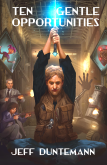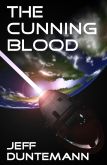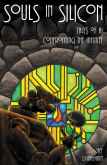It’s done. The first draft of The Everything Machine. I had a lot of trouble with Chapter 57, but a bit of focus and a couple of false starts got it where I knew it had to go. The first draft is now complete. It came in at 131,000 words, which is more than Dreamhealer but less than The Cunning Blood. I’ll most likely carve a couple thousand words out of it, though I paid more attention than usual to dead end scenes and promises early in the manuscript that the later chapters could not fulfill. There just won’t be as much scrap as there usually is.
The Everything Machine Is set in the same universe as The Cunning Blood. just elsewhere in the galaxy. A starship carrying 872 people plus gene-pool plants and animals for the Erewhon colony does a black fold and instead ends up…somewhere. Part of the mystery of the Metaspace stories is that everywhere there is a Sun-like star there is an Earth-like planet. The black fold destroyed the starship’s Hilbert drive, so there’s no going back. Starship Origen’s people and cargo shuttle down to the Earthlike planet’s surface and struggle to survive.
But…there are these alien…things. Clearly artificial, each consists of a 2-meter wide bowl half-filled with silver-gray dust. Beside the bowl is a low platform and two pillars, all made of some indestructible black stone. A teenage boy discovers that if you tap out a 256-bit binary pattern on the two pillars (one pillar for 0, the other for 1) something will coalesce and surface in the bowl. These (early) artifacts are all composed of a silver-gray metal that doesn’t scratch, bend, melt, or allow itself to be pounded flat in a forge. Some are familiar, like axes and shovels. Some are twisted lumps of silver-gray metal that don’t look like anything humans have ever seen.
The inhabitants of a world the inadvertent colonists eventually dub Valeron initially refer to the items produced by the alien machines as “thingies.” As people get used to tapping on the pillars (which respond with a sound for each tap, one pillar high, the other pillar low) they begin calling the artifacts “drumlins” because you drum on the pillars and drumlins appear in the bowl. Yes, I know that a drumlin is a glacial landform, but I repurposed the word because 95% of humanity have never heard it and it worked well in the story.
Planet Valeron is found to have hundreds of thousands of these machines (which are soon dubbed “thingmakers” because that’s what they do) scattered across the planet’s one big continent. Across over 250 years the population survives and grows, largely with the help of the thingmakers and the drumlins they produce. 261 years in, people ride horses and steam locomotives, but clever folk find a lot of useful things in the thingmakers, and begin compiling an index. Five minutes tapping on the pillars with that index in front of you, and you get a new (and indestructible) something. Shovels, hammers, pipe fittings, lengths of pipe, and much, much more.
Drumlins are peculiar in a number of ways. Besides being indestructible, drumlins will not hurt you. Take a drumlin knife to your dinner and it cuts your lamb chop just fine. Force the point of the same knife against the palm of your hand and the blade flattens out into a disk. Pull it back from your hand and it slowly returns to the form of a knife. How does the damned thing know?
That’s only one mystery of many surrounding the thingmakers. Remember Magic Mikey’s “players” from The Cunning Blood? They’re here. If they want to talk to you, they insert words into your consciousness. Talking back to them is tricky but it can be done, especially by peculiar teen girls.
I introduced the Drumlins World in a novelette called “Drumlin Boiler,” which appeared in IASFM for April 2002 and is in my collection Cold Hands and Other Stories. Jim Strickland and I wrote a double novel about the Drumlins World back in 2011. I adapted “Drumlin Boiler” as the first part of The Everything Machine, because it introduces the thingmakers, drumlins, and several characters who play a major role in the story.
There are truckloads of Jeff Duntemann ideas in the novel, but I took extra care to create characters who made sense and could be understood as human beings who could well be friends and loved ones, facing a phenomenon both mysterious and wonderful. I tossed in a couple of low-key love stories. There are fights, explosions, 6-shooters (and 11-shooters) hydrogen airships, sheriffs, starships built by humans and also by, well, whoever created the thingmakers.
That’s as much as I can tell you right now without getting into spoilers. Note well that I still have a huge amount of work to do. I have to do a continuity pass, and either do or hire someone to do an edit pass. Oh, and a cover. That may be the toughest challenge of all.
There are several finish lines in the craft of writing novels. I just got past the first. Plenty others are waiting in the wings, itching for me to cross them.
I’ll keep you posted on how the game is going.













